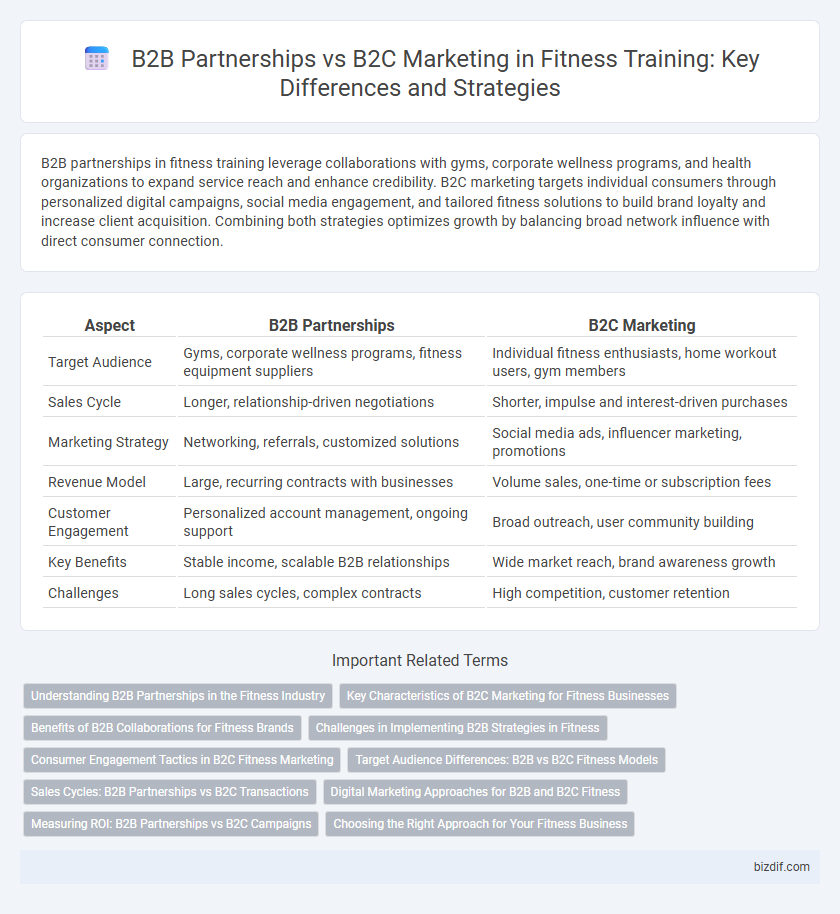B2B partnerships in fitness training leverage collaborations with gyms, corporate wellness programs, and health organizations to expand service reach and enhance credibility. B2C marketing targets individual consumers through personalized digital campaigns, social media engagement, and tailored fitness solutions to build brand loyalty and increase client acquisition. Combining both strategies optimizes growth by balancing broad network influence with direct consumer connection.
Table of Comparison
| Aspect | B2B Partnerships | B2C Marketing |
|---|---|---|
| Target Audience | Gyms, corporate wellness programs, fitness equipment suppliers | Individual fitness enthusiasts, home workout users, gym members |
| Sales Cycle | Longer, relationship-driven negotiations | Shorter, impulse and interest-driven purchases |
| Marketing Strategy | Networking, referrals, customized solutions | Social media ads, influencer marketing, promotions |
| Revenue Model | Large, recurring contracts with businesses | Volume sales, one-time or subscription fees |
| Customer Engagement | Personalized account management, ongoing support | Broad outreach, user community building |
| Key Benefits | Stable income, scalable B2B relationships | Wide market reach, brand awareness growth |
| Challenges | Long sales cycles, complex contracts | High competition, customer retention |
Understanding B2B Partnerships in the Fitness Industry
B2B partnerships in the fitness industry involve collaborations between gyms, equipment manufacturers, and wellness service providers to create synergistic growth opportunities. These partnerships focus on shared resources, co-branded marketing, and integrated service offerings that enhance client retention and operational efficiency. Understanding the strategic alignment of goals and leveraging industry-specific expertise are crucial for maximizing the impact of B2B collaborations.
Key Characteristics of B2C Marketing for Fitness Businesses
B2C marketing for fitness businesses emphasizes direct consumer engagement, leveraging personalized content and social media platforms to build brand loyalty and drive membership sales. Key characteristics include targeted promotions, influencer collaborations, and user-generated content that highlight individual wellness journeys and motivate potential clients. By focusing on emotional connections and convenience, fitness brands effectively capture attention and convert prospects into active participants.
Benefits of B2B Collaborations for Fitness Brands
B2B collaborations offer fitness brands access to specialized expertise, expanded networks, and shared resources that enhance service quality and operational efficiency. Partnering with gyms, health professionals, or equipment manufacturers creates scalable growth opportunities and increases brand credibility within the fitness industry. These alliances enable fitness brands to leverage bulk purchasing, co-marketing strategies, and innovative product development, leading to sustained competitive advantages.
Challenges in Implementing B2B Strategies in Fitness
Implementing B2B strategies in fitness faces challenges such as longer sales cycles and complex decision-making processes involving multiple stakeholders. Companies must tailor their offerings to meet the specific needs of gyms, corporate wellness programs, and health clubs while ensuring scalable solutions. Effective data integration and sustaining ongoing client relationships require significant investments in CRM systems and personalized communication strategies.
Consumer Engagement Tactics in B2C Fitness Marketing
B2C fitness marketing leverages personalized consumer engagement tactics such as targeted social media campaigns, influencer partnerships, and interactive workout apps to boost brand loyalty and customer retention. Utilizing data analytics, marketers craft customized fitness challenges and reward programs that motivate users and enhance user experience. These strategies directly address consumer needs and preferences, increasing active participation and driving higher conversion rates.
Target Audience Differences: B2B vs B2C Fitness Models
B2B fitness training targets corporate clients, gym chains, and wellness programs, focusing on long-term contracts and scalable solutions that improve employee health and reduce organizational costs. B2C fitness models directly engage individual consumers seeking personalized workouts, lifestyle coaching, and flexible membership options tailored to their unique fitness goals. Understanding these distinct audiences allows fitness businesses to craft effective marketing strategies--B2B emphasizing professionalism and ROI, while B2C highlights motivation, convenience, and personal transformation.
Sales Cycles: B2B Partnerships vs B2C Transactions
B2B partnerships in fitness training typically involve longer sales cycles due to complex decision-making processes and contract negotiations with businesses or organizations. B2C transactions, by contrast, focus on quicker sales cycles driven by individual consumer purchases influenced by immediate needs and personal fitness goals. Understanding these differing timelines is crucial for tailoring marketing strategies to optimize conversion rates in both markets.
Digital Marketing Approaches for B2B and B2C Fitness
B2B partnerships in fitness leverage LinkedIn and industry-specific platforms to build relationships with gyms, trainers, and wellness companies through targeted content and email campaigns, emphasizing ROI and long-term collaboration. In contrast, B2C marketing utilizes social media channels like Instagram and TikTok, influencer partnerships, and personalized ads to engage individual fitness enthusiasts by promoting lifestyle benefits and community experiences. Both approaches rely on data analytics and SEO to optimize reach and conversion but tailor messaging and platforms to distinct audience behaviors and decision-making processes.
Measuring ROI: B2B Partnerships vs B2C Campaigns
Measuring ROI in fitness training reveals that B2B partnerships often yield higher long-term value through client retention and bulk contract renewals, while B2C marketing campaigns provide immediate but sometimes smaller-scale revenue spikes via direct consumer engagement. Metrics such as customer lifetime value (CLV) and conversion rates are essential for both models, with B2B relying more on contract duration and partnership stability compared to B2C's focus on customer acquisition cost (CAC) and sales volume. Fitness businesses must tailor analytics tools to track these distinct KPIs for optimizing marketing spend and partnership efficacy.
Choosing the Right Approach for Your Fitness Business
B2B partnerships in fitness training enable collaboration with gyms, corporate wellness programs, and healthcare providers to expand service reach and create scalable revenue streams. B2C marketing targets individual consumers through social media campaigns, personalized fitness content, and local advertising to drive direct engagement and client acquisition. Selecting the right approach depends on your fitness business's goals, resource capacity, and desired market penetration, balancing long-term partnerships against immediate consumer visibility.
B2B Partnerships vs B2C Marketing Infographic

 bizdif.com
bizdif.com